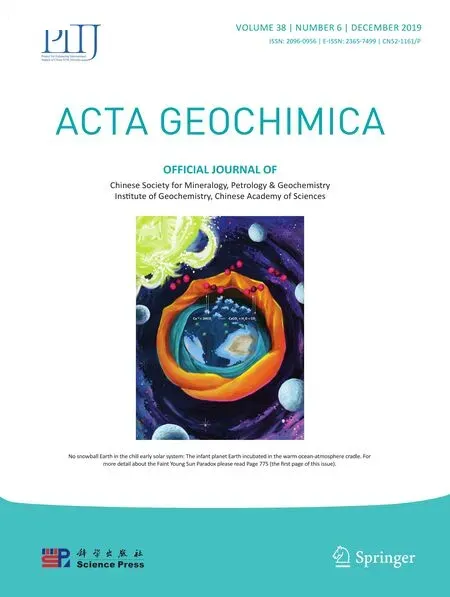Petrography and tectonic provenance of the Miocene Surma Group in parts of the Naga-Manipur hills,in and around Nungba,Northeast India
Angom Sangeeta·N.Pandey·Oinam Kingson
Abstract The Miocene molassic Surma sandstones in parts of the Naga-Manipur hills,in and around Nungba,Northeast India have been studied for their tectonic provenance using petrography and heavy mineral contents.The poorly-to-moderately-sorted sub-litharenite to lithicarkose type Surma sandstones display predominance of monocrystalline quartz(av.61%)and include undulose and non-undulose varieties and almost equal amounts of feldspars(av.22%)and rock fragments(av.17%).The heavy mineral suite of Surma sandstones is dominated by transparent varieties(96%)that include garnet,zircon,tourmaline, rutile, staurolite, scapolite, phlogopite,chondrodite,humite,wollastonite,hedenbergite.sphene,chlorite,sillimanite,glauconite,glaucophane,and chloritoid.These heavy minerals characterize the granitic and silicic metamorphic complexes(GM)as well as the basic metamorphic rocks(MT)like greenstones,green schist,and amphibolites relating to passive continental margin setup.The opaque grains constitute nearly 4%of the total heavy minerals.The presence of euhedral,as well as abraded heavy mineral grains,further supports a mixed provenance having substantial contribution from sedimentary and metamorphic rocks.A ZTR index of approximately 45%indicates mineralogically sub-mature nature of Surma sandstones.Based on the light and heavy mineral suites coupled with the type of terrain available in the vicinity of the study area,it may be visualized that the sediment supply was largely made by the Himalaya,the IMR,the Shillong plateau,and the Mikir Hills under the influence of semi-arid to semi-humid climatic conditions.An overall supply from a recycled orogen provenance has been envisaged.
Keywords Petrography·Tectonic provenance·Miocene·Surma Group·Naga-Manipur hills·Nungba,Northeast India
1 Introduction
The Manipur and adjoining region of Northeast India forms an important segment of a major orogenic belt named the Indo-Burma Range (IBR, now IMR=Indo-Myanmar Range,Fig.1)that links Himalayan orogen to the North and Andaman Nicobar islands to the South.The IMR has experienced both the subduction and collisional tectonic activities (Mitchell 1993) and thus provides a unique opportunity to study the pre-, syn-, and post-orogenic records.One such record belonging to the Miocene postorogenic phase has been named the Surma Group.The Surma Group of rocks is well exposed in the states of Manipur, Mizoram, Meghalaya, Nagaland, Assam, and Tripura.The works of Mallet(1876),Oldham(1883),Evans(1932,1964)and Mathur and Evans(1964)are the only basis for any type of geological studies in the region.Nevertheless,Nandy(1983),Sengupta et al.(1990),Soibam (1998), Srivastava et al. (2004), Kushwaha and Chandra(2008),Devi and Mondal(2008),Chandra et al.(2010),and Srivastava and Pandey(2011)provided valuable information on the regional geological framework including tectonics,lithostratigraphic,and sedimentological aspects of the neighbouring areas.
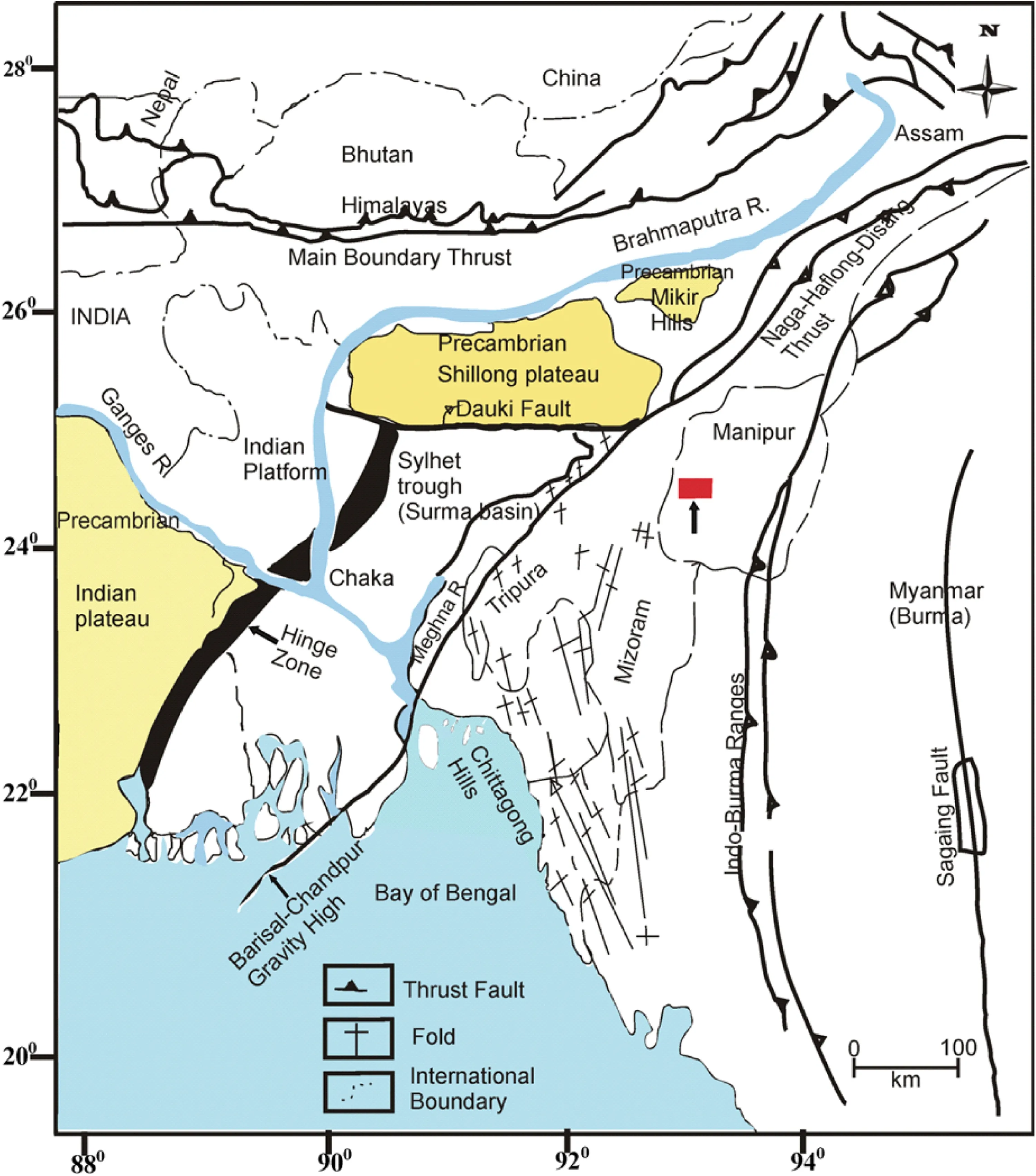
Fig.1 Regional tectonic setting(after Uddin and Lundberg 1998a,b)of the study area(arrow)
Present investigation mainly concerns the study of tectonic provenance and plaeoclimate based on petrographic data and heavy mineral studies.In recent years Dickinson and Suczek(1979),Suttner and Dutta(1986),Morton(1987),and Sen et al.(2017)provided a comprehensive relationship between sandstone composition and plate tectonics,heavy minerals,and provenance,besides paleoclimate.As no published work concerning the subject matter is available except for sporadic references, the present investigation is expected to provide impetus to ongoing research activities in the region.
1.1 Geology of the study area
The study area forms a part of the Inner fold belt of the Naga-Manipur hills,which is occupied by two synclinoria,namely Kohima synclinorium to the South and Patkai synclinorium to the North.The study area is located within the Kohima synclinorium,where Surma sediments constitute the core of the synclinorium.It is bounded between latitudes 24°45′–24°50′N and the longitudes 93°20′–93°30′E of the topographic sheet Nos.83H/5,83H/6 and 83H/9 of the Survey of India,covering nearly 30 sq in and around Nungba,Noney District,Manipur India(Fig.2).
2 Materials and methods
Petrographic studies were performed using thin sections of 19 representative rock samples at the Department of Earth Science,Assam University,Silchar,Assam.Rock samples were collected in time and space from the Miocene Surma Group in parts of the Naga-Manipur hills,in and around Nungba,Manipur.Rock thin sections were prepared at the Department of Earth Science,Manipur University,Imphal using rock cutter and grinders.The cut-sections of rockswere mounted on glass slides using araldite gum and then grinded further through different grades of abrasives(carborundum powder)until the sample attained a standard thickness of 30 μm.Apart from petrography,the modal analysis was carried out using the Gazzi–Dickinson method(Dickinson 1970;Ingersoll et al.1984).Nearly 450 points were counted in each thin section and the data thus generated on modal composition of Surma sandstones were presented in Tables 1 and 2.Classification and symbol of grains types used in QFt,QmFLt and QtFLt are presented in Table 3.
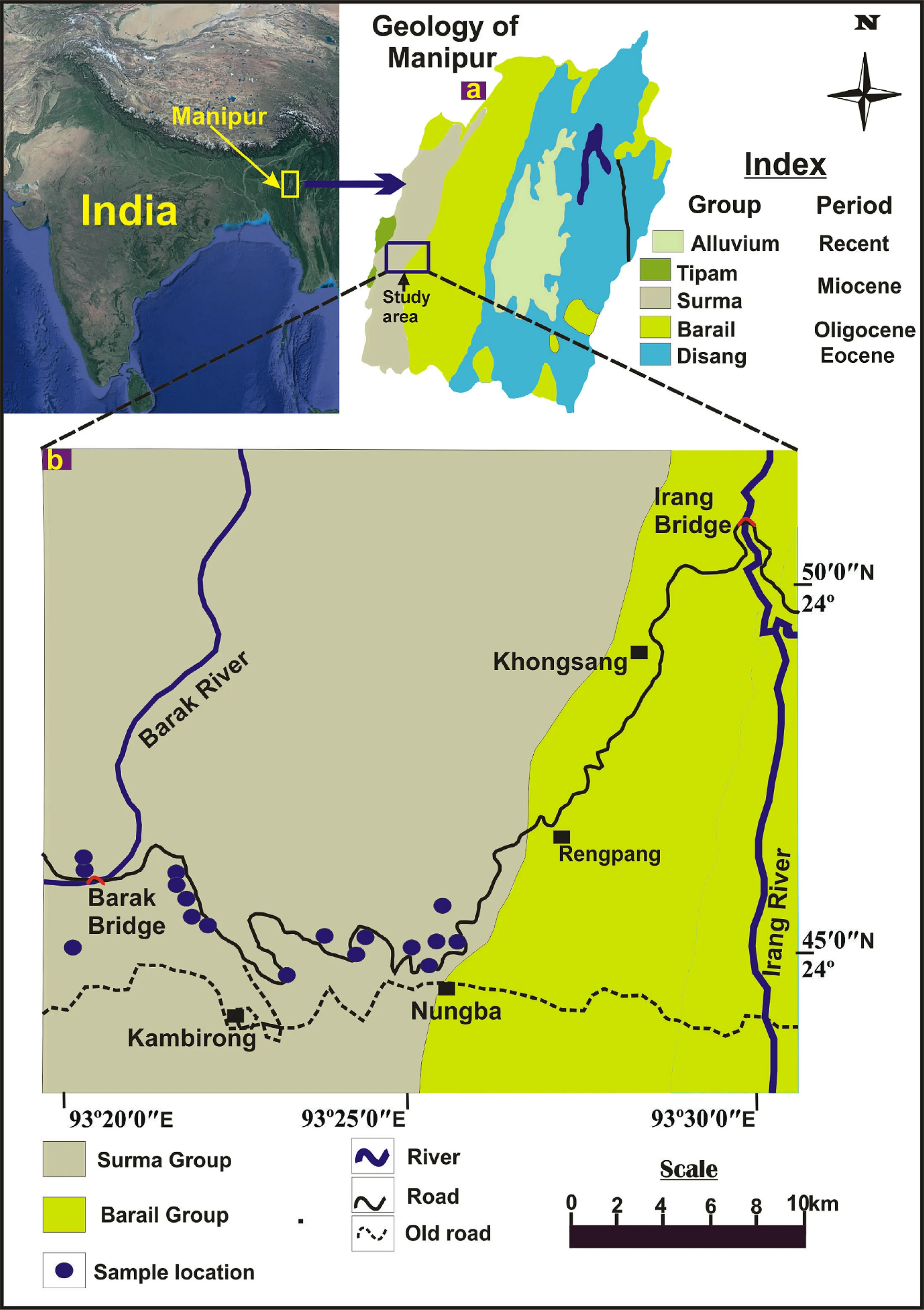
Fig.2 a Geological map of Manipur(modified after Soibam 1998)showing location of the study area,and b geological map of the study area(modified after Chandra et al.2010)showing sample locations
The same number of samples was also analyzed for the heavy minerals employing density separation technique suggested by Folk(1980)and Middleton(2003).Gently crushed and dried samples were soaked with H2O2overnight for disintegration.On washing and drying,each disintegrated sample was treated with dilute HCl and SnCl2followed by boiling for nearly 5–10 min so as to removethe iron coating,authigenic clay,and carbonate coatings on the grains.Each sample was thoroughly washed with water.Nearly 2 to 2.5 gm of each processed dried samples were poured into a separating funnel containing heavy liquid bromoform(sp.gr.2.89)and allowed to stand for about 10 min so as to gain maximum heavy mineral yield.The heavy minerals thus settled were released from the separating funnel and retained on the filter paper.On drying,the heavy mineral residues were then mounted on glass slides using Canada balsam and studied for mineral identification under the petrological microscope at the Department of Earth Science,Assam University,Silchar.
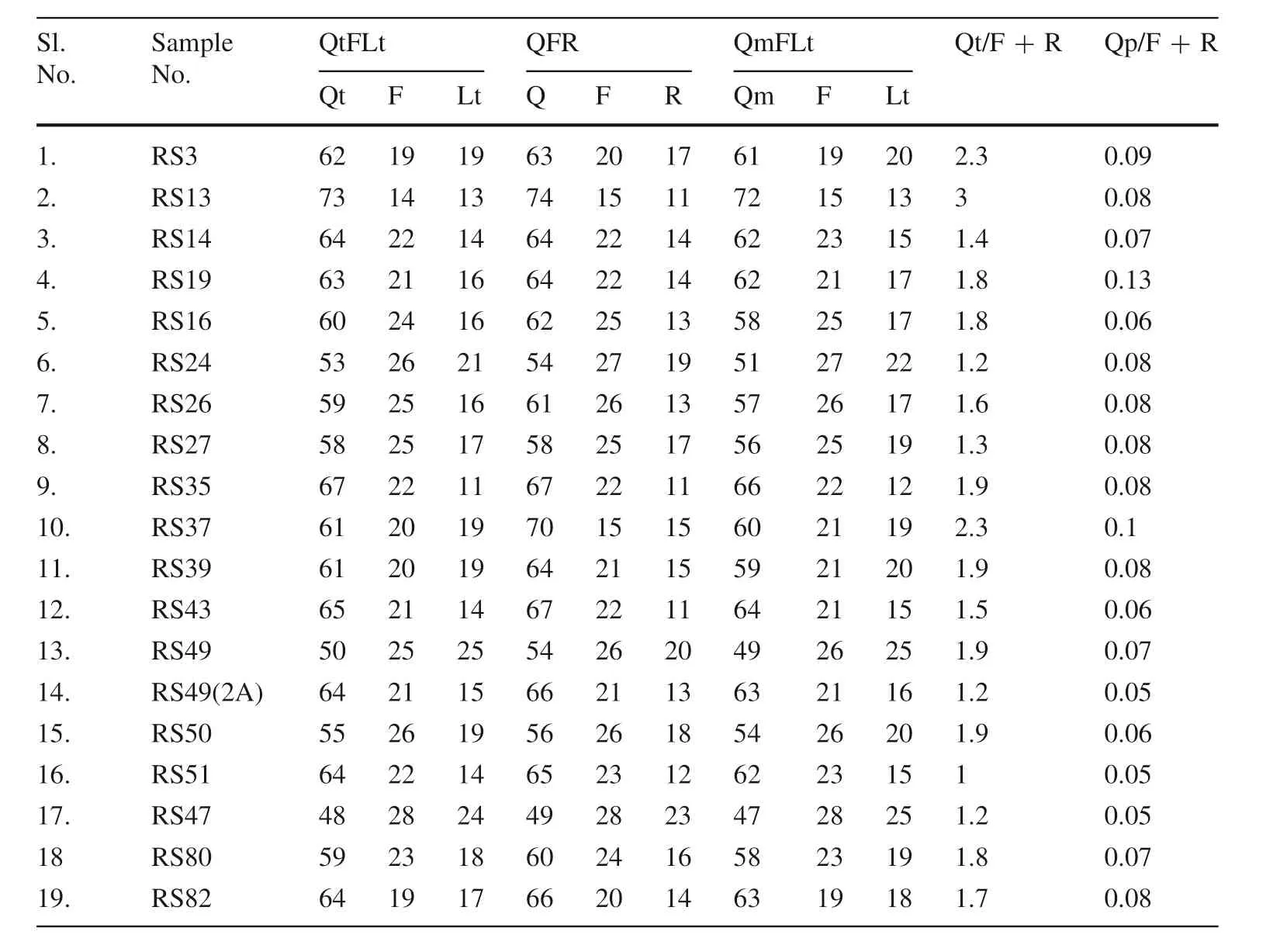
Table 1 Recalculated modal composition(in%)of Surma sandstones in parts of Naga-Manipur hills,Noney district Manipur
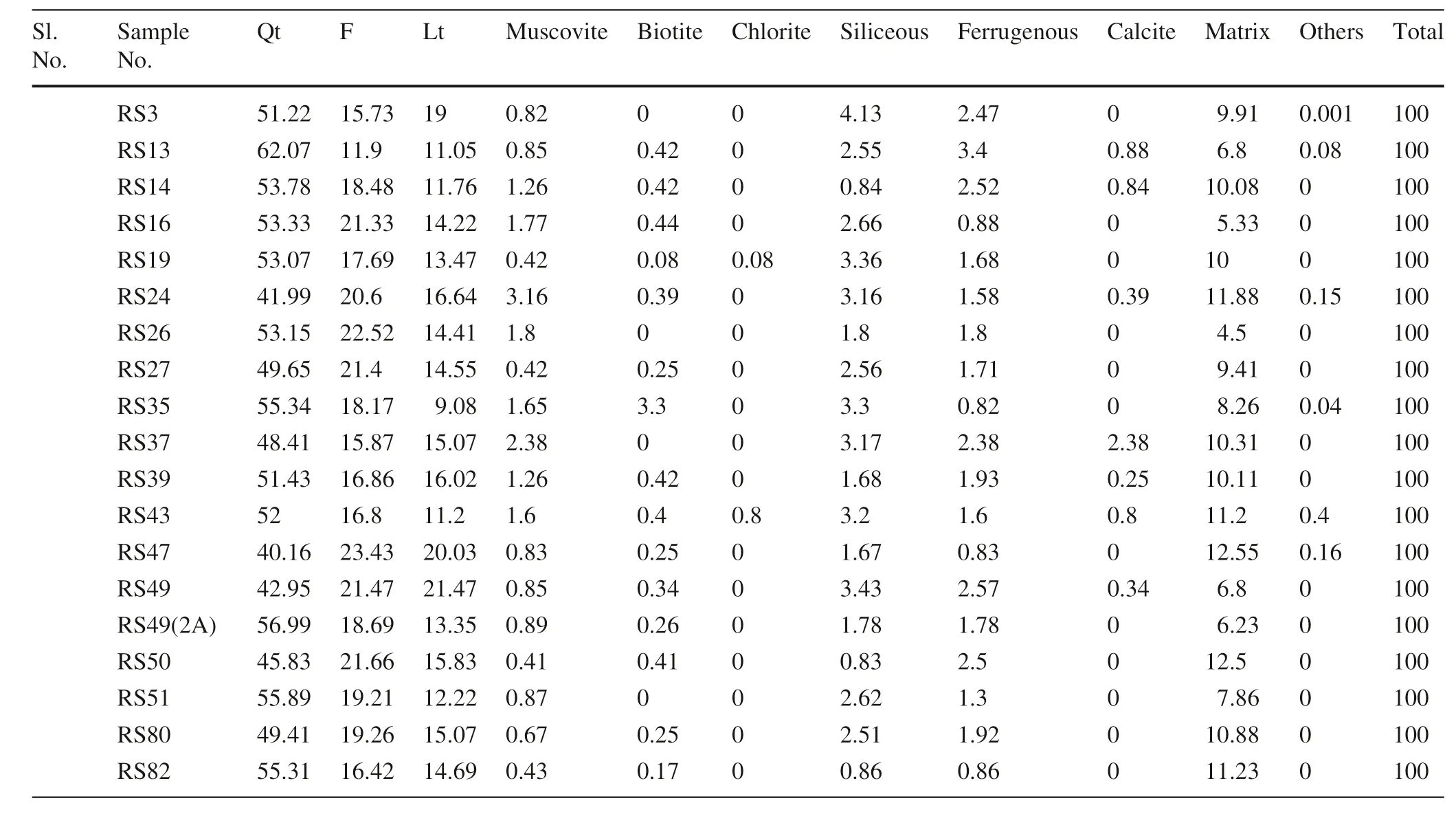
Table 2 Modal analysis(in%)of Surma sandstones in parts of Naga-Manipur hills,Noney district Manipur
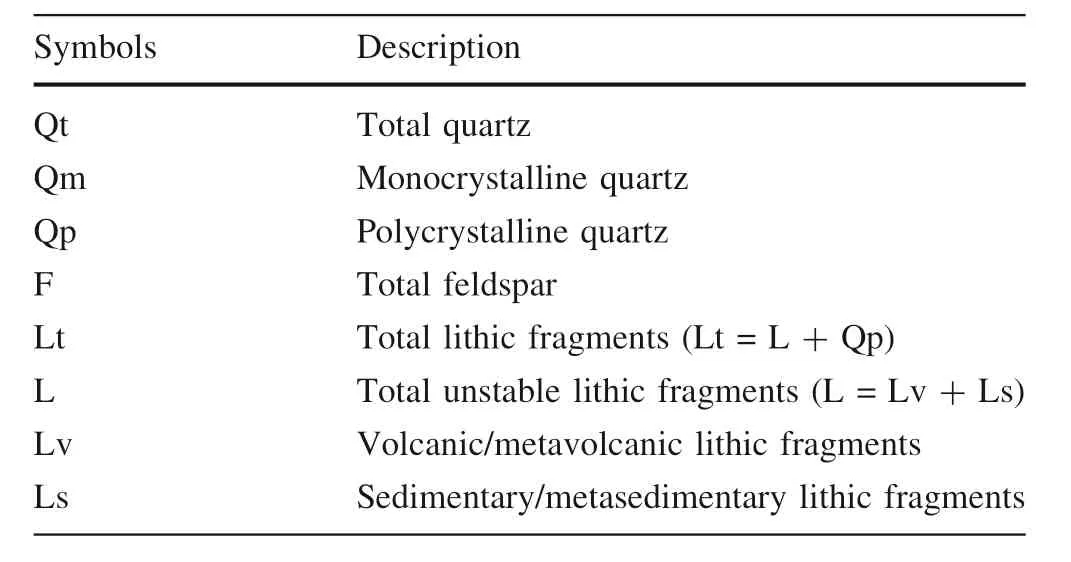
Table 3 Classification and symbol of grains types used in QFLt,QmFLt and QtFLt(after Dickinson 1985;Trop and Ridgeway 1997)
3 Results
3.1 Sandstone petrography
The framework grains of the Surma sandstones(Fig.3)are predominantly composed of monocrystalline quartz(50–73%), feldspar (14–28%), and lithic fragments(11–25%).The other detrital minerals include muscovite,biotite, chlorite, and heavy minerals. The cementing material is dominantly silica with minor content of ironoxide and calcite.Among framework grains quartz is the most abundant constituent and includes undulatory(Fig.3a), non-undulatory (Fig.3b), and polycrystalline(Fig.3c)varieties(P 2–3 units and P >3 units).
Feldspar grains mostly possess sub-angular to subrounded and even angular outlines.Both plagioclase and K-feldspar varieties are present(Fig.3d,e).K-feldspars(approximately 11%,Table 2),including orthoclase and microcline,dominate over the plagioclase feldspars(approximately 8%, Table 2). Shale siltstone and chert(Fig.3f, g) constitute the sedimentary rock fragments whereas physillites(Fig.3h)and volcanic(Fig.3i)rock fragments characterize the metamorphic igneous varieties.Among micas,muscovite(Fig.3i,j)dominates over biotite(Fig.3k).However,some chlorite flakes were also seen.A complex mixture of finely constituted recrystallized(appx.4 μm) sericite and chert filling the intergranular pore spaces has been identified as matrix(Fig.3l).In addition,Surma sandstones depict different degrees of compaction including point,long,concavo-convex,sutured contact,and isolated or floating grains.Point and long contacts reflect early diagenetic changes whereas concavo-convex and sutured contacts relate to late diagenetic changes while isolated or floating grains with corroded boundaries may be attributed to near complete replacement of quartz by matrix.Quartz overgrowth,which is a rim of cement chemically attached to the crystal lattice of existing detrital grains,is also present.Both the syntaxial(Fig.3m)and epitaxial(Fig.3n)overgrowths were observed.Besides silica cement(Fig.3a,e),iron oxide(Fig.3j)and calcite(Fig.3f)were also observed in the Surma sandstones.Silica cement(av.2.42%;Table 2)is most dominant followed by iron oxide and calcite.Fe-oxide cement(av.1.81%;Table 2)occurs as thin coatings around detrital grains and as scattered aggregates of pore-filling cement while the calcite cement(av.0.31%;Table 2)occurs as poikilotopic patches filling the intergranular pores between detrital grains.
The Surma sandstones were classified using the method suggested by Folk(1980).By and large,the composition of Surma sandstones ranges between sub-litharenite and lithic-arkose(Fig.4).The modal composition of Surma sandstones, used in deciphering tectonic provenance through QFLt,QmFLt,and QtFLt(Figs.5,6 and 7)diagrams after Dickinson et al.(1983)and Dickinson and Suczek(1979),has been presented in Table 1.
3.2 Heavy mineral analysis
The heavy mineral suite in the Surma sandstones(Fig.8)depicts a cosmopolitan nature.Non-opaque heavy minerals(96%)dominate over the opaque grains(4%).The percentages of non-opaque and opaque heavy minerals in the Surma sandstones are shown in Table 4 and graphically represented in Fig.9.Among various shapes,only 15%are found to be euhedral and the remainder(85%)as recycled.All opaque grains are assumed to be ironoxide minerals. Transparent varieties include garnet,zircon,tourmaline,rutile,staurolite,scapolite,phlogopite,chondrodite,humite,wollastonite,hedenbergite.sphene,chlorite,sillimanite,glauconite,glaucophane,and chloritoid. The garnet, zircon, tourmaline, and rutile (including anatase) are the most prominent varieties constituting 26%,23%,14%,and 10%,respectively of the total transparent heavy minerals. Staurolite occursmostly as euhedral and subhedral grains comprising nearly 4% of the total transparent heavy minerals whereas all other species including phlogopite,sphene,scapolite,humite,glauconite,glaucophane,wollastonite,sillimanite,chlorite,chloritoid,chondrodite,and hedenbergite vary between 1%and 15%(av.4.3%).
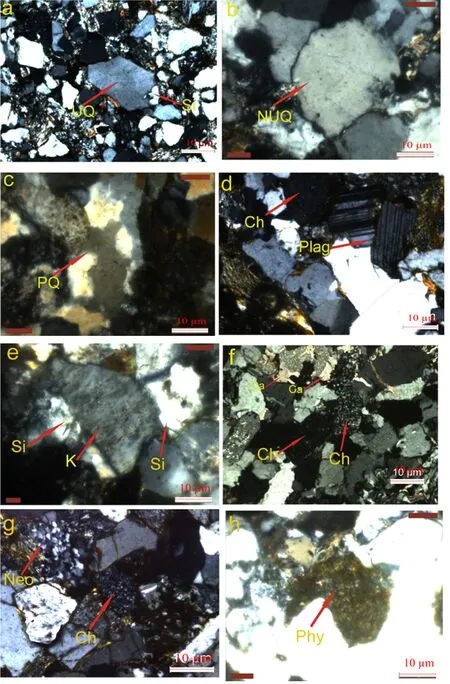
Fig.3 Photomicrographs showing a undulatory quartz(UQ)and Silica cement(Si),b non undulatory quartz(NUQ),c pollycrystalline quartz(PQ),d plagioclase feldspar(Plag),e orthoclase feldspar(K)and Silica cement(Si),f chert rock fragment(Ch)and calcite(Ca),g chert rock fragment(Ch)and Neo-quartz(Neo),h Physillite(Phy),i Igneous rock fragment(Ig)and Muscovite(Mus),j Muscovite(Mus)and Ferruginous cement(Fe),k Biotite(Bio),l Matrix(Ma)and Quartz grains(Q),m Syntaxial overgrowth,n Epitaxial overgrowth,o Heavy mineral(HM)

Fig.3 continued
4 Mineralogical maturity
The Mineralogical maturity of sandstone is characterized by an increasing percentage of stable constituents,i.e.quartz and chert, and a decreasing content of unstable constituents,i.e.feldspar and rock fragment(Folk 1980).The mineralogical maturity can also be assessed on the basis of ZTR index using heavy mineral data(Pettijohn 1984,Hubert 1962).The ZTR index in respect of Surma sandstones has been found to be approximately 45%,revealing minerologically sub-mature nature.The presence of high percentage of feldspar and rock fragments further supports the sub-mature nature of Surma sandstones.
5 Tectonic provenance
In order to understand the provenance of the Surma sandstones,19(nineteen)representative samples were analyzed for heavy mineral using a gravity settling technique.The majority of the heavy mineral species(18)belong to the non-opaque category. Following Singh et al. (2004),Adhikari and Wagreich(2011),and Srivastava and Pandey(2011),an attempt has been made to categorize heavy mineral suites using the discriminatory plot suggested by Nechaev and Isphording(1993).In the plot,zircon,tourmaline,staurolite,and less commonly andalusite,monazite,and kyanite have been considered to be derived from Earth’s sialic crust and hence constitute the GM group of heavy minerals.The basic metamorphic minerals including pale and blue-green amphiboles,epidote,and garnet together constitute the MT suite whereas the MF group is dominated by mafic minerals like olivine,pyroxene,and basaltic hornblende.The heavy mineral suites of the Surma Group of rocks belong only to GM and MT categories that characterize a passive continental margin set-up(Fig.10).This is further supported by the presence of a substantial amount of reworked heavy minerals.In order to interpret the plate tectonic setting of Surma sandstones,the triangular plots QFLt,QmFLt,and QtFLt(Figs.5,6 and 7)after Dickinson et al.(1983)and Dickinson and Suczek(1979)were used.Almost all the sandstone samples occupy the recycled orogen field except for a few falling near the boundary of the recycled orogen indicating substantial supply from recycled orogen involving minor contribution from mixed provenance(subduction complex,collision complex,cratonic sources,and arc orogenic provenance).This inference is in good agreement with those derived from the heavy mineral suite.
6 Palaeoclimate
The climate and plate tectonics are considered as the two universal controls on the sandstone composition(Miall 1984).Many attempts have been made to interpret the palaeoclimate and plate tectonic settings using modal composition(Dickinson and Suczek 1979)and chemical composition(Suttner and Dutta 1986)of clastic sedimentary rocks.In order to interpret the palaeoclimate of Surma sandstones,the bivariate log–log plot after Suttner and Dutta(1986)have been used.The Surma Sandstones were found to occupy the field of semi-arid to semi-humid climate(Fig.11).This inference is further substantiated byrelatively high matrix,feldspar,and lithic content of poorly sorted Surma sandstones.
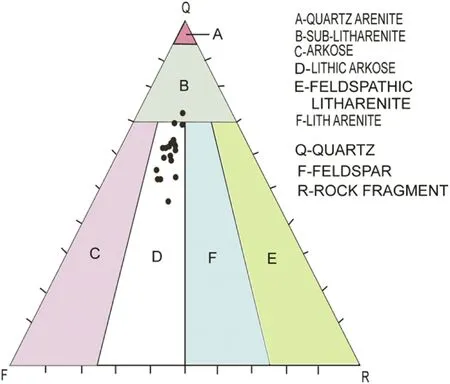
Fig.4 QFR plot(after Folk 1980)showing classification of Surma sandstone
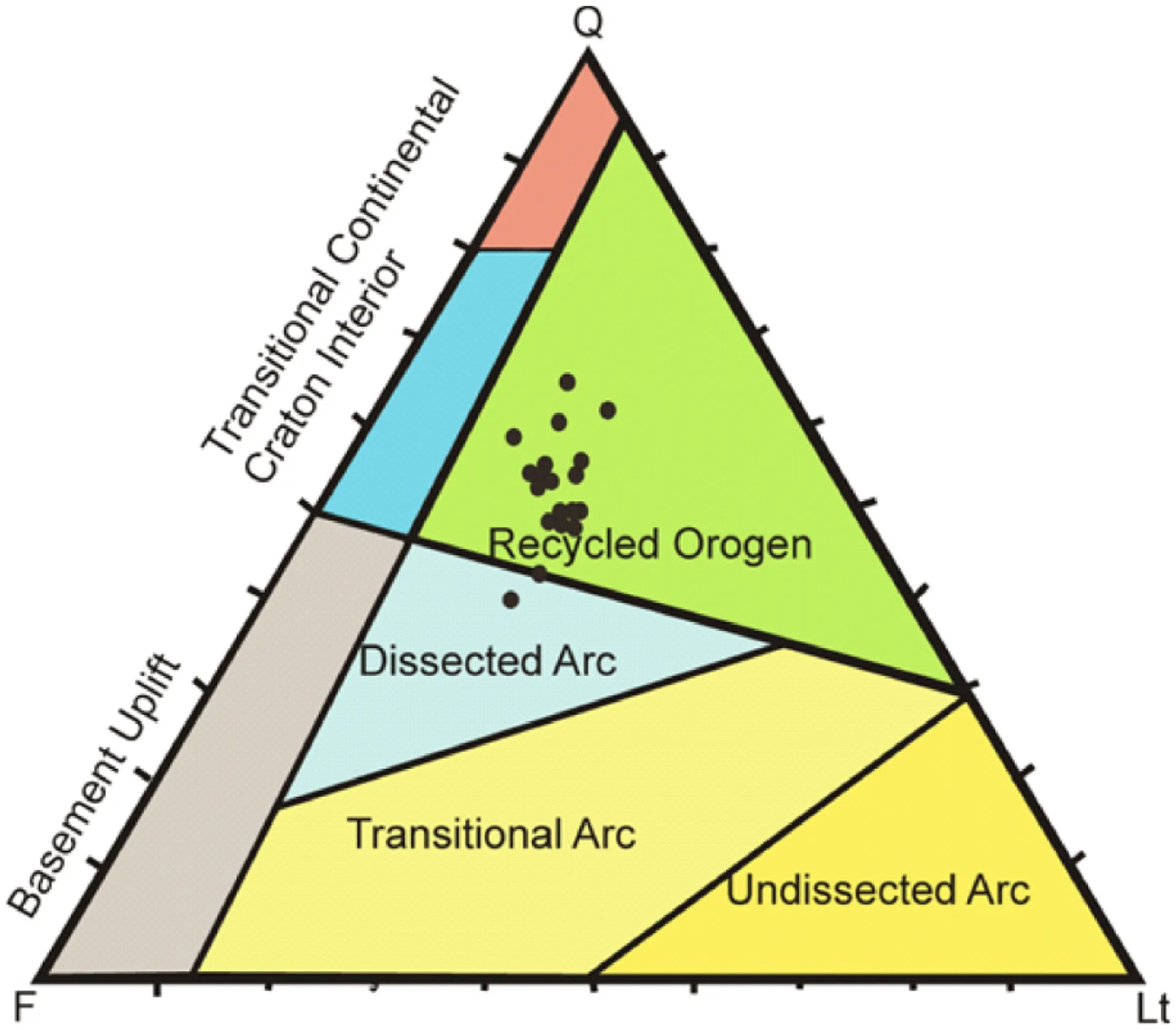
Fig.5 QFLt plot(after Dickinson et al.1983)of Surma sandstone showing the dominantly recycled orogen provenance
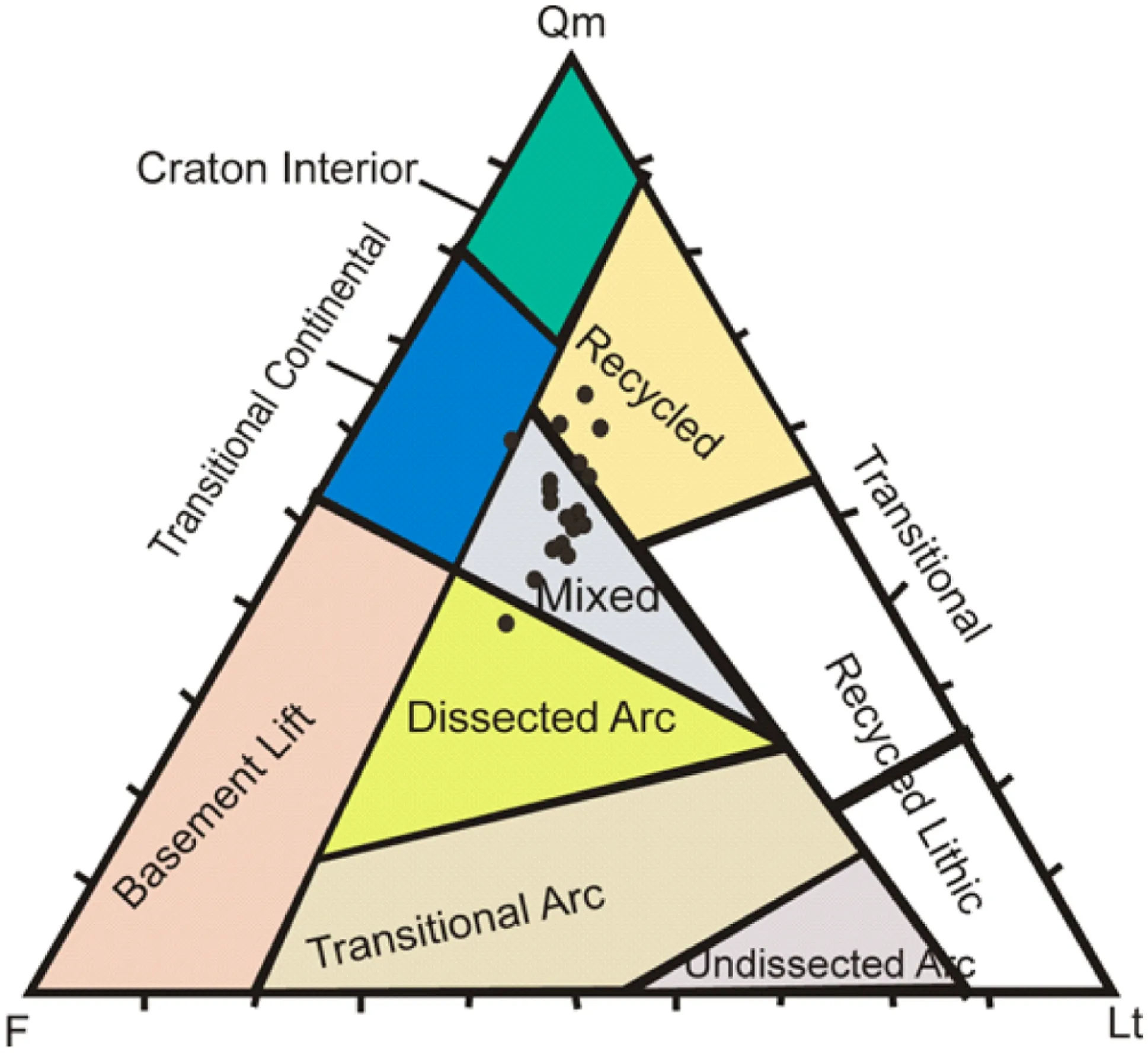
Fig.6 QmFLt plot(after Dickinson et al.1983)of Surma Sandstone showing the derivation of Surma sediments from mixed source terrain,showing contribution from recycled orogen
7 Discussion
Petrographically,Surma sandstone is comprised of quartz and an almost equal amount of feldspar and lithic fragments.Among the quartz varieties,undulatory quartz is the most dominant.It indicates derivation from a medium-rank metamorphic source of variable pressure effects(Basu et al.1975).On the other hand,the presence of recycled non-undulatory quartz together with sedimentary lithic fragments including chert point towards a sedimentary source(Blatt and Christies 1963).Negligible amount of polycrystalline quartz together with rounded quartz grains showing distinct abraded overgrowth further suggest sedimentary recycling (Blatt and Christies 1963). Among feldspar varieties,the presence of alkali feldspar is being attributed to granitic sources,whereas plagioclase feldspar relates to volcanic and metamorphic sources.Nevertheless,a high K-feldspar/Plagioclase ratio of Surma sandstones points towards cratonic derivation(Nesbitt et al.1997),i.e.the Shillong plateau and/or the Mikir Hills in respect of studied Surma sandstones.On the other hand,an abundance of lithic fragments in the Surma sandstones does indicate supply from newly uplifted Indo-Myanmar as well as Himalayan orogens(Devi and Mondal 2008).
The above findings are further substantiated by the cosmopolitan nature of the heavy mineral suite in the Surma sandstone.The presence of euhedral zircon,tourmaline(schorlite),rutile(anatase),and garnet(inclusion free)indicate derivation from granitic and mafic igneous rocks(Mishra and Tiwari 2005).In addition,the occurrence of euhedral–subhedral staurolite,sillimanite,kyanite,chlorite,glaucophane,and garnet(with inclusion)may be assigned to a regionally metamorphosed source terrain.In addition, the presence of chondrodite, phlogopite,scapolite,wollastonite,sphene,and hedenbergite in Surma sandstones signifies a contact dolomitic marble and skarn source rock(Sangeeta and Pandey 2017).Further,the occurrence of recycled abraded grains of zircon,tourmaline,rutile,glauconite,garnet etc.in Surma sandstone suggests supply from a sedimentary source.The presence of such a diversified suite of heavy minerals comprising sedimentary,metamorphic,and igneous derivations thus indicates a mixed provenance.
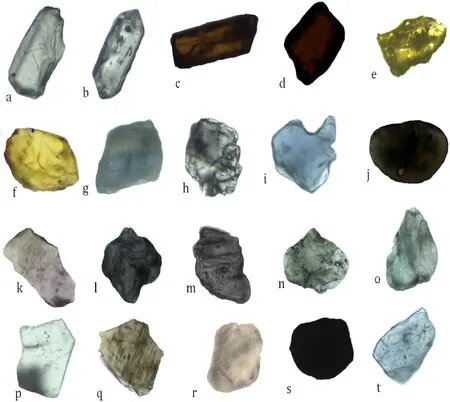
Fig.8 Heavy minerals in Surma sandstones a garnet,b zircon,c tourmaline,d rutile,e anatase,f staurolite,g glaucophane,h sphene,i wollastonite,j phlogopite,k kyanite,l glauconite,m chloritoid,n chondrodite,o chlorite,p humite,q sillimanite,r scapolite,s iron-oxide,t Hedenbergite
8 Conclusions
On the basis of the above observations it may be concluded that the basin received detritus mostly from recycled orogen with minor contribution from mixed provenance i.e.subduction complex,collision complex,cratonic sources,and arc orogenic provenance.This is further substantiated by the dominance of monocrystalline quartz grains and the recycled abraded grains taken together in addition to the occurrence of schist rock fragments,tectonised mica,chert rock fragments,and a diversified suite of heavy minerals.The study reveals that compositionally Surma sandstones belong to the sub-litharenite and lithic-arkose category.A ZTR index of approximately 45%further indicates the mineralogically submature nature of Surma sandstones.The heavy minerals suite of Surma sandstones belong only to MT and GM categories reflecting a passive continental margin set-up.Based on the light and heavy mineral suites coupled with the type of terrain available in the vicinity of the study area,it may be visualized that the sediment supply was largely made by the rising Himalaya,the IMR,the Shillong plateau,and the Mikir Hills.A semi-arid to semi-humid climatic condition has been envisaged during the deposition of Surma sandstones.
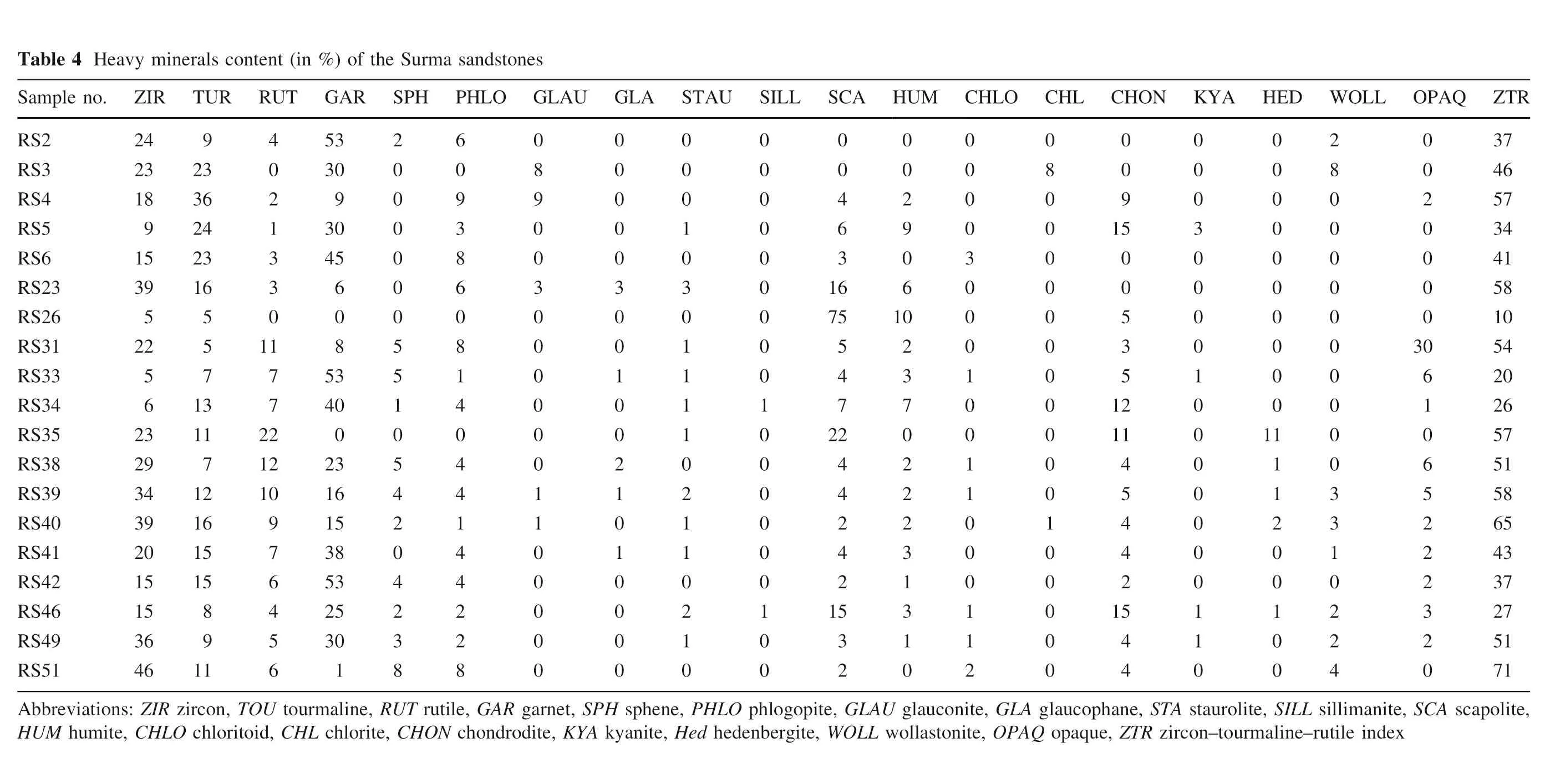
?
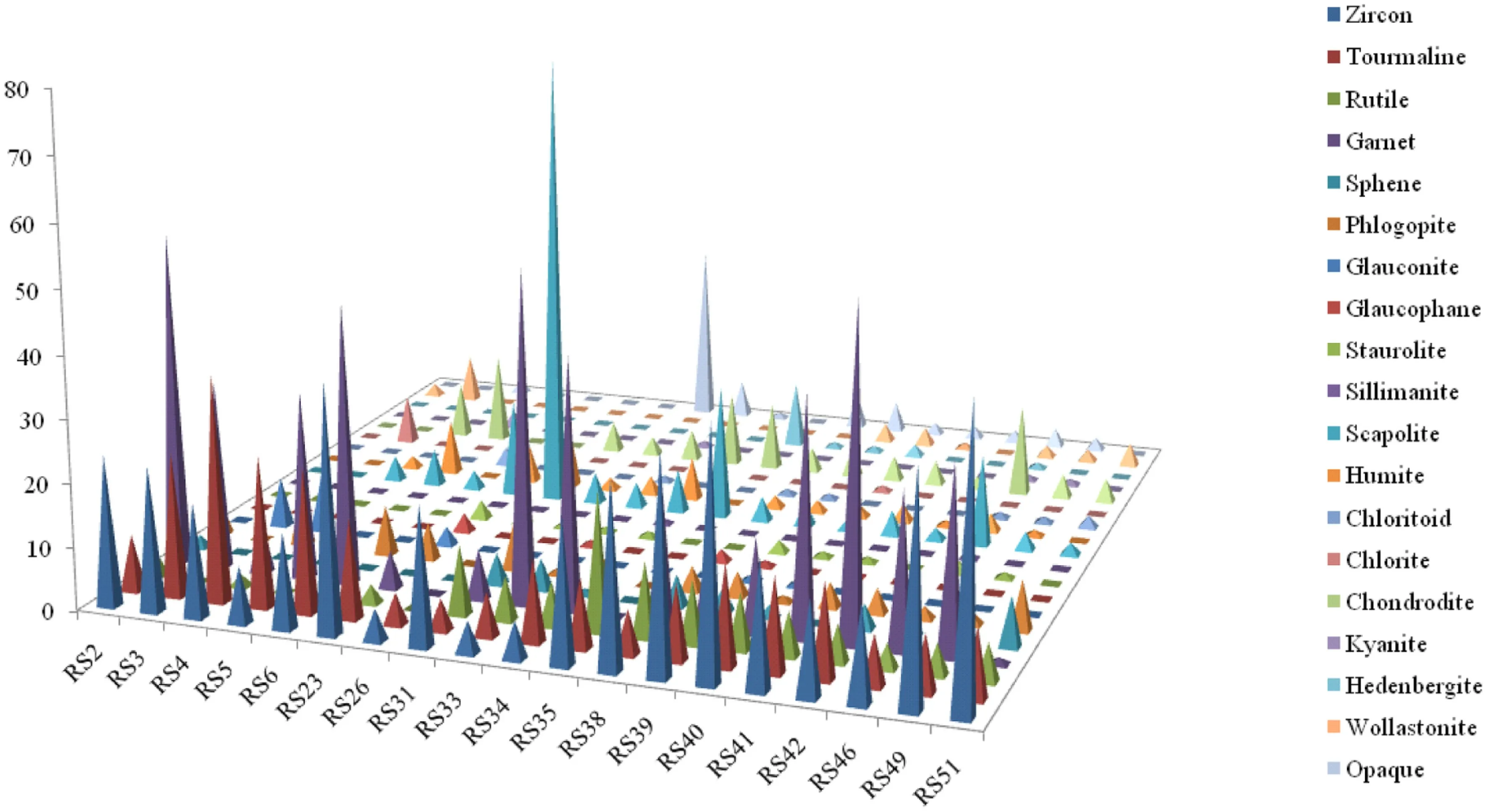
Fig.9 Heavy minerals distribution in Surma sandstones of the study area
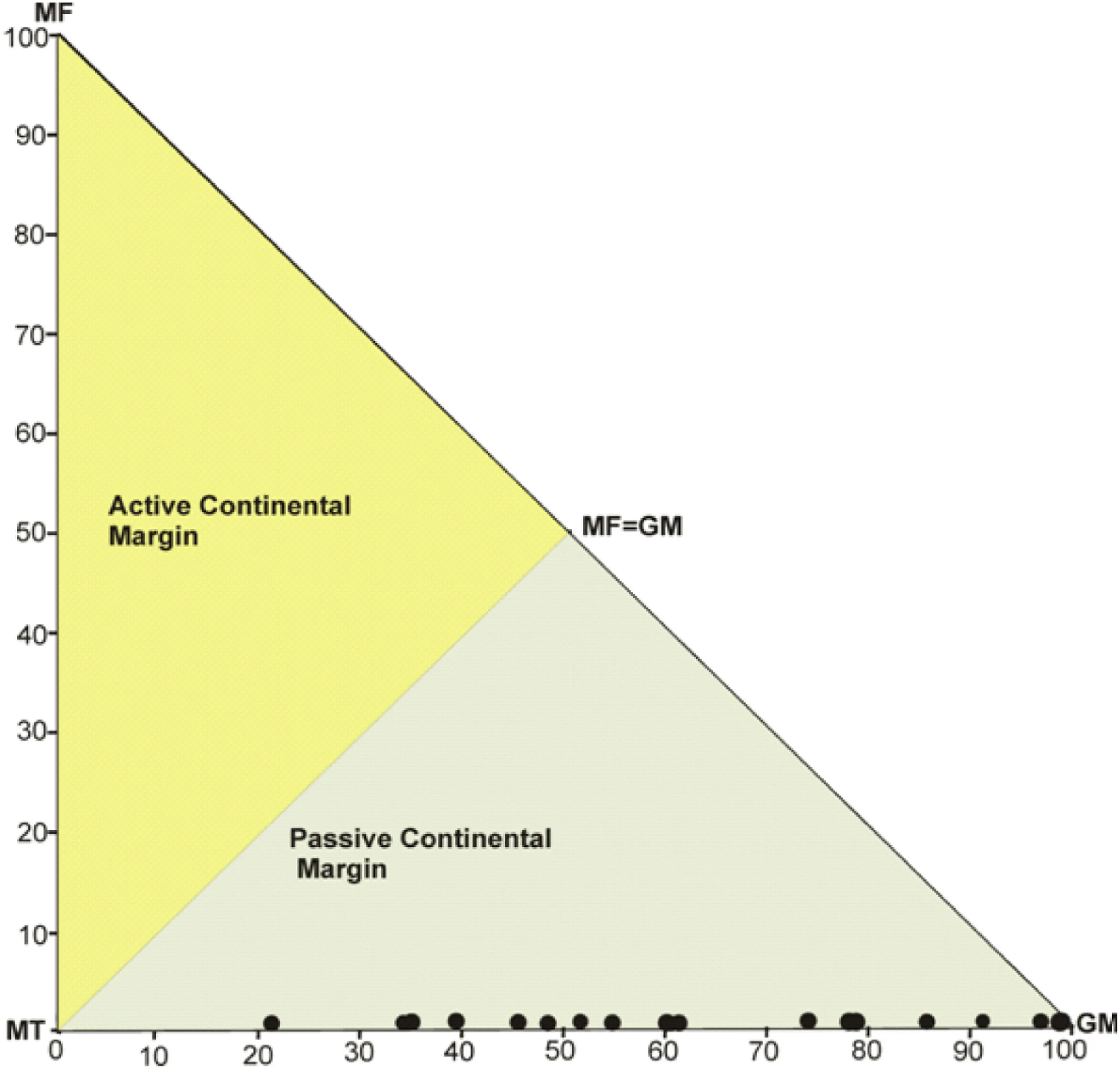
Fig.10 Plot of MF–MT–GM(after Nechaev and Isphording 1993)of heavy minerals showing a passive continental margin for the formation of Surma sandstones.MF=Total content of hornblende,pyroxene and olivine.MT=Total content of epidote,garnet and amphiboles.GM=Total content of zircon,tourmaline,staurolite,kyanite,sillimanite and zoisite
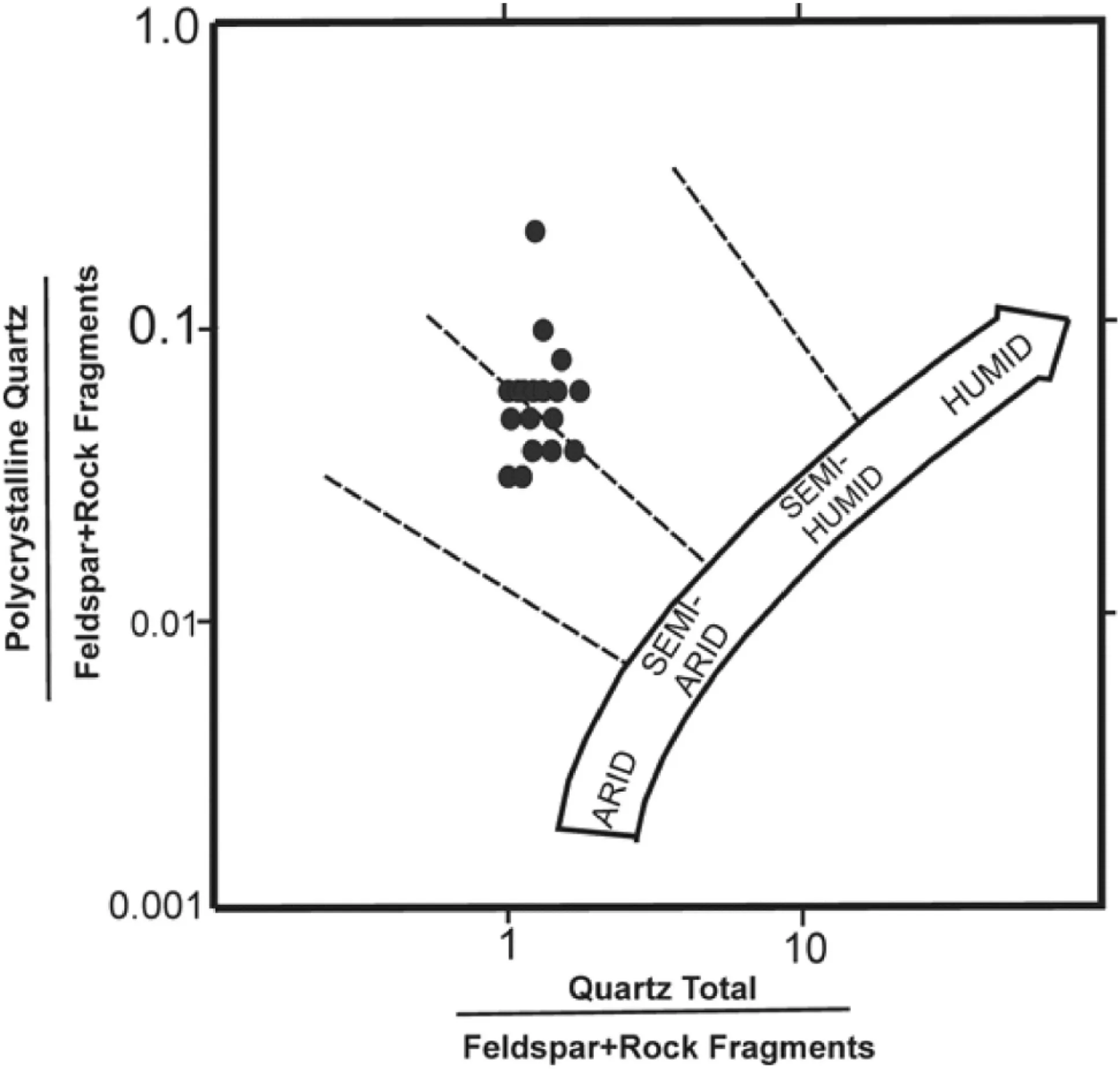
Fig.11 The bivariate log–log plot of Qp/(F+R)versus Qt/(F+R)(after Suttner and Dutta 1986)showing semi arid to semi humid palaeoclimate
Acknowledgements The first author is grateful to the DST,New Delhi for funding the research programme through Inspire Fellowship No.IF140996.The authors are also thankful to the Department of Earth Science,Assam University,Silchar,Manipur University,Canchipur and ONGC,Sibsagar for providing laboratory facilities and other necessary supports for carrying out the research.
- Acta Geochimica的其它文章
- Whole-rock geochemistry of Tertiary sediments of Mizoram Foreland Basin,NE India:implications for source composition,tectonic setting and sedimentary processes
- Petrogenesis,geochemistry and geological significance of Paleocene Granite in South Gangdese,Tibet
- An experimental study on dynamic coupling process of alkaline feldspar dissolution and secondary mineral precipitation
- Isotherm and kinetic studies on the adsorption of humic acid molecular size fractions onto clay minerals
- REE geochemistry of gangue minerals and their geological significance in the Muli antimony ore deposit in Yunnan,China
- Study on Late Cretaceous-Cenozoic exhumation of the Yanji area,NE China:insights from low-temperature thermochronology

